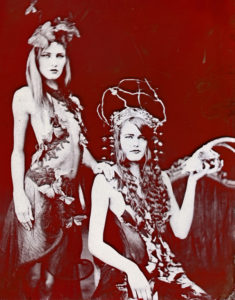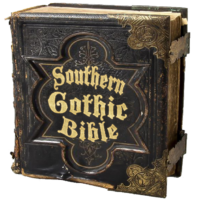
Allan Barnes is an editorial and fine art photographer from Detroit, Michigan, where he was a contributing photographer to the New York Times, Detroit Free Press, Spin, and Metropolis Magazine. After 25 years as an editorial photographer, he began working in the Wet Plate Collodion Process and currently specializes in portraiture and fashion as well as modern gothic tintype photography. He has also worked as a freelance photojournalist and voice-over artist in Mexico DF, Mexico. His studio is in the North San Francisco Bay Area, where he also teaches photography classes at Petaluma High School.
Allan Barnes conducts workshops in 19th Century Wet-Plate photography. He also does commissioned tintype and ambrotype portraits.
- What process do you work with?

- I work with wet plate collodion, which includes both tintypes and ambrotypes. Ambrotypes are glass-based images where glass plates are soaked in silver nitrate with collodion is binding the silver to the plate. Tintypes are not made on tin, but on aluminum sheets and it’s essentially the same process. Tintypes are a little bit easier because the material we use, called trophy plates, is sheets of aluminum with a baked-on black enamel and it is commonly used in engraving and therefore more readily available.
- What attracted you to the tintype process?
- It’s very slow, very deliberate, very messy and very smelly. It’s very physical – you’re always moving around, and the reason I think I liked photography in the first place was because it involved a lot of moving around and not just sitting in a chair in front of a desk. When you’re in the darkroom you are moving around and as a journalist you are constantly going different places and taking pictures of different people. That too was a very fascinating career, but very difficult to get a good job in. I did get into photojournalism as the newspapers were starting to close, so it was a really bad time to get into the field, but I still wanted to do
 it. In the 90s I started working with Polaroids and doing a lot of work for myself on the side. Around 1996 I also had a job that lasted about a year working for a magazine and the publisher was a very brilliant Pulitzer Prize winning photographer named Manny Crisostomo who used to work at the Detroit Free Press. He pushed me to experiment and I started working with larger formats again, using Polaroid type 55 film, doing Polaroid transfers. However by 2002 it became obvious that Polaroid was in deep trouble and was not going to survive. At about that time I moved out to Los Angeles from Detroit and that was pretty much the end of my photo journalistic career and I had to reinvent myself. Around that period I have seen some alternative process images and wet plate work being done by contemporary artists. I saw an original daguerreotype of the burning Twin Towers on 911 by Jerry Spagnoli on display in New York and was really haunted by it and became interested in making daguerreotypes. I also saw a series of wet plate images by Robert Maxwell – a series of portrait of actors and actresses, models and kids and his work drew me toward wet plate as well. I was at this fork in the road as I was attracted to both technologies, but when I found out that you had to burn mercury to develop daguerreotypes I decided to go with wet plate collodion.
it. In the 90s I started working with Polaroids and doing a lot of work for myself on the side. Around 1996 I also had a job that lasted about a year working for a magazine and the publisher was a very brilliant Pulitzer Prize winning photographer named Manny Crisostomo who used to work at the Detroit Free Press. He pushed me to experiment and I started working with larger formats again, using Polaroid type 55 film, doing Polaroid transfers. However by 2002 it became obvious that Polaroid was in deep trouble and was not going to survive. At about that time I moved out to Los Angeles from Detroit and that was pretty much the end of my photo journalistic career and I had to reinvent myself. Around that period I have seen some alternative process images and wet plate work being done by contemporary artists. I saw an original daguerreotype of the burning Twin Towers on 911 by Jerry Spagnoli on display in New York and was really haunted by it and became interested in making daguerreotypes. I also saw a series of wet plate images by Robert Maxwell – a series of portrait of actors and actresses, models and kids and his work drew me toward wet plate as well. I was at this fork in the road as I was attracted to both technologies, but when I found out that you had to burn mercury to develop daguerreotypes I decided to go with wet plate collodion.
Interview by The Photo Palace
Featured image: Heathen Apostles



